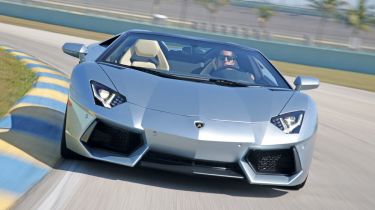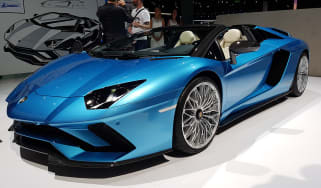Lamborghini Aventador Roadster review
The Lamborghini Aventador Roadster gets a removable carbon-fibre roof and mighty V12 engine - but it comes at a price

The Lamborghini Aventador Roadster is one of the fastest and most ostentatious open-topped cars on the planet. It shares its stunning angular styling, carbon-composite chassis and mighty V12 engine with the Aventador coupe. The two-piece carbon-fibre roof panels have to be removed by hand but they only weigh 6kg and can be stored in the nose. A unique engine cover with hexagonal glass adds to the breathtaking styling, while 200mph+ performance means it rivals cars like the Pagani Zonda and Ferrari 458 Spider.
Engines, performance and drive
The Aventador Roadster weighs 50kg more than the coupe, but with a power output of 690bhp it delivers similarly breathtaking performance. In the right environment it will reach a top speed of 217mph and sprint from 0-62mph in just three seconds, while the grippy four-wheel-drive system ensures there’s loads of grip. There’s no perceivable twist in the body and thanks to a strengthened chassis the Roadster feels identical to the coupe. It isn’t as agile as cars like the Ferrari 458, but the V12 engine sounds amazing and there’s no escaping the wow factor you get from behind the wheel.
MPG, CO2 and Running Costs
For those lucky enough to be able to afford a near-£300,000 roadster, fuel bills are unlikely to be a major worry. Which is just as well as the Roadster is not cheap to run. Although, with standard stop-start and cylinder deactivation, the V12 engine is far more fuel efficient than V12 models of old. And with a 90-litre fuel tank you can achieve a respectable range in normal driving conditions. Insurance bills will be hefty but Lamborghini now has six dealers in the UK for servicing and maintenance.
Interior, design and technology
Low, wide and aggressive, the bold octagonal shapes and upward opening scissor doors of the Aventador are brutish but effective - and few cars attract quite as many stares. The Roadster’s revised B-pillars include roll over protection, while the unique engine cover has a pair of hexagonal windows that allow you to admire the stunning V12 engine. The beautifully trimmed cabin looks great bathed in sunshine and, as with the coupe, features a host of high-end Audi-derived switchgear. The dials behind the steering wheel adopt a futuristic feel with an ultra modern digitised TFT screen.
Practicality, comfort and boot space
The carbon-fibre roof panels have to be taken in and out by hand, so the Aventador lacks the touch-of-a-button practicality of cars like the McLaren 12C Spider. They are light and the operation is fairly straightforward, but storing them reduces luggage space in the nose. As with the coupe the offset pedals take time to get used to and the ride is firm, while the sheer size of the Lamborghini limits day-to-day practicality. However, the hydraulic nose lifter raises the front suspension allowing you can get into car parks or driveways without scraping the front splitter.
Reliability and Safety
Sales of the Aventador coupe have passed the 1,000 mark since it was first introduced in 2011, and Lamborghini’s flagship model is still in huge demand with no horror stories over reliability. Audi’s influence means the flimsy switchgear and temperamental electrics of old are long gone. When it comes to safety, the Roadster’s revised B-pillars offer rollover protection, while the composite chassis forms a survival cell in an accident. Like the coupe, stability control, ceramic brakes and an active rear wing are fitted as standard. The rear-view camera is essential, helping to overcome poor rear visibility when parking.








